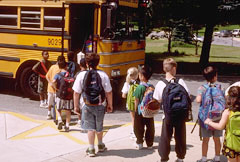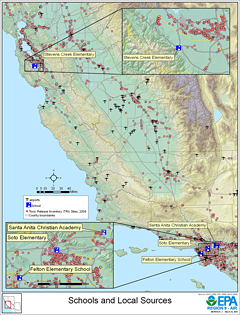Contact EPA Pacific Southwest Air Program
Pacific Southwest, Region 9
Serving: Arizona, California, Hawaii, Nevada, Pacific Islands, Tribal Nations
Assessing Outdoor Air Near Schools
Announcements
October 2011
Data Available for three Southern California Schools | Datos disponibles para la escuela
- Felton Elementary (Lennox)
- Bright Kids Montessori Academy (Formerly Santa Anita Christian Academy) (El Monte)
- Soto Street Elementary School (LA)
October 2011
August 2009
- Data Available for Stevens Creek Elementary School
- Monitoring to begin at Southern California schools this week
National Information
Regional Links
En Español
- Hoja Informativa Escuela Felton Elementary
- Hoja Informativa Escuela Bright Kids Montessori Academy (Antiguamente Santa Anita Christian Academy)
- Hoja Informativa Escuela Soto Street Elementary
- Hoja Informativa Escuela Stevens Creek
On this page:
- What is EPA’s School Air Toxics Monitoring Initiative?
- How Many Schools Will Be Monitored Under This Initiative?
- How Did EPA Decide Which Schools To Monitor?
- Which Schools Will EPA Be Monitoring in Region 9?
- Why Isn’t My School On the List of Schools for Monitoring?
- What Can Schools Do to Improve Air Quality?
- Other Frequently Asked Questions (FAQs)
- For More Information
- National Press Release
- Regional Press Release
What is EPA’s School Air Toxics Monitoring Initiative?

As part of a new air toxics monitoring initiative, EPA, state and local air pollution control agencies will monitor the outdoor air around schools for pollutants known as toxic air pollutants, or air toxics. The Clean Air Act includes a list of 187 of these pollutants. Air toxics are of potential concern because exposure to high levels of these pollutants over many decades could result in long-term health effects.
EPA selected schools after evaluating a number of factors including results from an EPA computer modeling analysis, the mix of pollution sources near the schools, results from an analysis conducted for a recent newspaper series on air toxics at schools, and information from state and local air pollution agencies.
EPA, and our state, local and tribal air pollution control partners are:
- collect samples of outdoor air near selected schools over 60 days,
- analyze those samples for air toxics of potential concern,
- report on levels of air toxics found and their potential for long-term health impacts,
- evaluate actions that may be needed to reduce levels of pollutants of concern, and
- take action as needed to ensure that nearby industries are in compliance with clean air regulations.
This web site provides information on this initiative in EPA’s Pacific Southwest Region (Region 9). For additional information, please visit the national Web site.
How Many Schools Will Be Monitored Under This Initiative?
The initial monitoring will take place at 62 schools in 22 states. If your school is not on the initial list of schools to be monitored, it does not mean it might not be monitored in the future. We will use what we learn from the initial round of monitoring to help us determine whether we may need to conduct additional monitoring.
How Did EPA Decide Which Schools To Monitor?
EPA identified schools for monitoring based on the best data available to us about air pollution in the vicinity of the school, information about wind direction and speed, results of a computer modeling analysis, results from a recent newspaper analysis,
![]() and information from state and local air agencies.
and information from state and local air agencies.
Which Schools Will EPA Be Monitoring in Region 9?
EPA Region 9, in partnership with the Bay Area Air Quality Management District ![]() and the South Coast Air Quality Management District
and the South Coast Air Quality Management District ![]() , will initially be monitoring at the following school locations. Please click on the school name for information regarding the monitoring efforts at each school, and on the name of the pollutant(s) for additional information.
, will initially be monitoring at the following school locations. Please click on the school name for information regarding the monitoring efforts at each school, and on the name of the pollutant(s) for additional information.
| School Name | City | State | Pollutant(s) to be monitored* |
|---|---|---|---|
| Felton Elementary School | Lennox | CA | Metals in TSP, PAH, VOC |
| Bright Kids Montessori Academy (Formerly Santa Anita Christian Academy) | El Monte | CA | Metals in TSP, PAH, VOCs |
| Soto Street Elementary School | Los Angeles | CA | Metals in TSP, PAH, VOCs |
| Stevens Creek Elementary School | Cupertino | CA | Cr+6 |
* Pollutants to be measured have been selected based on emission sources in the vicinity of each school.
|
|||
For information on all schools being monitored nationwide, please refer to the Assessing Outdoor Air Near Schools Web site.
Why Isn’t My School On the List of Schools for Monitoring?
EPA is going to start by monitoring at 62 priority schools in 22 states near large industrial facilitates and in some urban areas. If your school is not on the initial list of schools to be monitored, it does not mean it might not be monitored in the future. We will use what we learn from the initial round of monitoring to help us determine whether we may need to conduct additional monitoring
EPA Region 9 received a significant number of inquiries about monitoring schools in West Berkeley and Bayview/Hunters Point in San Francisco. EPA has prepared responses to these inquiries, which can be viewed below:
- Letter to West Berkeley Residents (PDF) (2 pp, 24K)
- Letter to Bayview-Hunters Point Residents (PDF) (2 pp, 23K)
What Can Schools Do to Improve Air Quality?
The air children breathe impacts their health. People exposed to toxic air pollutants at sufficient concentrations and durations may have an increased chance of health problems including damage to the immune system, and neurological, developmental, respiratory and other health problems including cancer. In some cases, children may be more vulnerable to these health effects than adults because:
- their bodies are still developing; and
- their behavior can expose them to more chemicals.
Learn more about children’s health issues
In addition to assessing outdoor air near schools, EPA has several existing programs that take action to help make the air in and around schools safer for children to breathe:
Indoor levels of air pollutants can be two to five times higher than outdoor levels. Sources of poor indoor air quality in schools range from inadequate ventilation systems to fumes from pesticides and cleaning agents. More than half of the nation’s schools are implementing indoor air quality management programs, most of which are based on EPA’s Tools for Schools Program, which helps schools identify, resolve and prevent indoor air quality problems using low- and no-cost measures.
EPA launched the Clean School Bus USA Program in 2003 to address the condition of America’s aging school bus fleet and the health effects that result from exposure to diesel exhaust emitted by idling school buses. EPA has provided grants to many school districts to fund the replacement of old school buses with new buses that use cleaner fuels.
EPA’s Healthy School Environments web site is a “one-stop shop” for resources and information on topics related to environmental health and safety in schools.
EPA is also taking action to be sure that levels of lead, ozone, and fine particle pollution in the air protect children’s health. Learn more about each:
Other Frequently Asked Questions (FAQs)
For More Information
If you have questions or need additional information about the School Air Toxics Monitoring Initiative in Region 9, you can emailR9schoolmonitoring@epa.gov, or call Michael Bandrowski, Chief of the Air Toxics, Radiation, and Indoor Air Office at EPA, Region 9, at (415) 947-4194.

